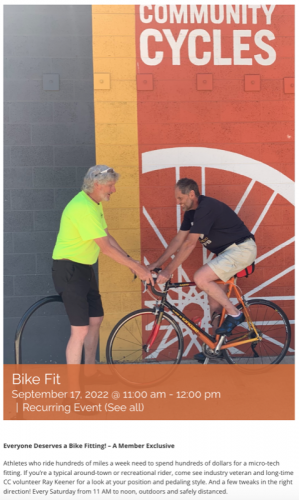My favorite "bike work" hour of the week is doing two or three free 30-minute bike fits at Boulder, Colorado's Community Cycles every Saturday morning. I work with a wide variety of riders, and I find myself repeating the same things over and over. Hence the "broken record."
Bike fitters in shops rarely work with the "regular folks" I see every week. And yet, these casual riders represent the majority of your customers. So I'm writing up my experiences in hopes they may be useful to retail staff and less-experienced fitters alike.
Backstory
I've been fitting bikes in a formal, charge-for-it sense since 1980. At The Bicycle Outfitter in Los Altos, California, we bought one of the first Fit Kits from Bill Farrell of the New England Cycling Academy. I was the manager, so I declared myself "the fitter" and dove right in.
And yes, the Fit Kit was flawed. Since it was based on measurements from young, athletic cyclists, we quickly learned to make adjustments for older, slower riders. The RADs in the Kit (Rotational Adjustment Devices) used for cleat fitting were truly revolutionary.
My first move toward mass fast fits came in 1986. I organized the 7-Eleven Summer of Cycling. Bill Woodul and Brook Watts drove a motorhome packed with product displays from one big century ride to the next, 16 in total. I flew in every weekend and did fittings. 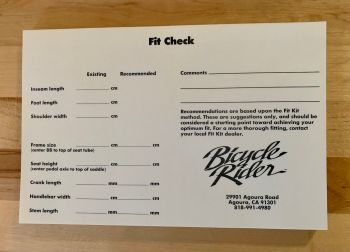
My Fit Kit and trainer traveled in the motorhome. I'd set up in a parking lot and do dozens of fittings over two days, and give the rider a "prescription" to take home to get serviced by their local shop if they needed a new stem or saddle.
I used the Fit Kit tools more for show than for function. By that point, I could pretty much look at people on a trainer and fill out the prescription. And as fitters know, the tools and the "show" gave riders more confidence in the results.
Process
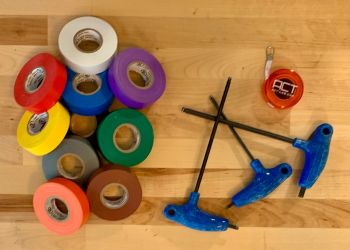 While I still own a Fit Kit, a plumb bob, a goniometer and such, all I take to Community Cycles are 4, 5 and 6 mm hex wrenches, a tape measure and my reminder tapes. I no longer use a trainer, since that can take up time I can't afford when I only have 30 minutes.
While I still own a Fit Kit, a plumb bob, a goniometer and such, all I take to Community Cycles are 4, 5 and 6 mm hex wrenches, a tape measure and my reminder tapes. I no longer use a trainer, since that can take up time I can't afford when I only have 30 minutes.
I do what I call "dynamic fits," which is a couple of short rides on a quiet street in front of the shop. I take still photos and sometimes videos depending on the situation. Before we ride, I do a pretty standard rider interview.
The interview includes questions like: How long have you been riding? How long have you had this bike? Do you have other bikes? What kinds of riding do you do? What's your idea of a long ride? What do you like and not like about this bike? Do you have any pain, either while riding or just in general?
Few of my clients have ever been asked these questions before. Almost none of them have had a "formal" bike fit. They're Community Cycles members, commuters, casual road and mountain bikers. Maybe one in five rides in cleated shoes.
These folks would never seek out a paid shop fit, because few of them ride far or fast enough to consider it. Also, few of them are having severe or consistent pain. They come to me because I'm free, and I'm "enough" for their modest needs.
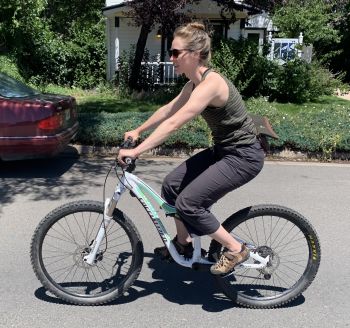
And I see the same fit issues, week after week. Shops do basic fit adjustments on new bikes, and most of my clients bought their bikes used on Craigslist or refurbished at Community Cycles.
Unless you look at people pedaling and talk to them about how they interact with the bike, they'll keep doing what they've done since, well, childhood. Because "once you learn to ride a bicycle, you never forget." Hence the reminder tapes.
After I get a sense of them as a rider and a look at their bike setup, we go out for a short ride. I take photos from the side, and if it's warranted by the situation, a video, usually from behind. It's cool to see how people react, none of them have ever seen themselves riding before!
Broken records
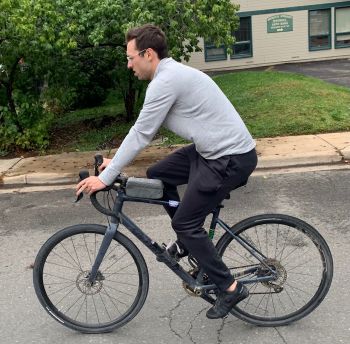 Then we head back to the shop and I launch into this list of my eight "broken record" questions and canned speeches before we do a second ride. Usually three or four records per rider, and I have occasionally used all eight. In part two (next week), I'll share more detail about what I say and why:
Then we head back to the shop and I launch into this list of my eight "broken record" questions and canned speeches before we do a second ride. Usually three or four records per rider, and I have occasionally used all eight. In part two (next week), I'll share more detail about what I say and why:
- Ever wonder why we call it a saddle, not a seat?
- OK, walk over to the jersey rack, turn around and walk back.
- OK, now maintain your back angle and steer with your fingertips.
- Let's move that saddle forward some, OK?
- Have you heard about the Specialized Experience Center?
- Rotate your pelvis forward a bit, now feel how your core engages to support your torso?
- Look with your eyes, not your whole head.
- What color reminder tape would you prefer?

